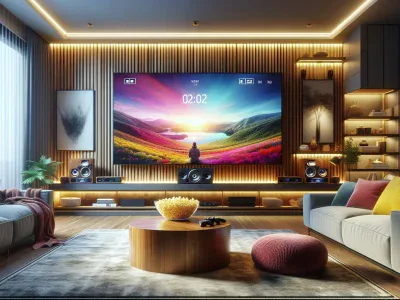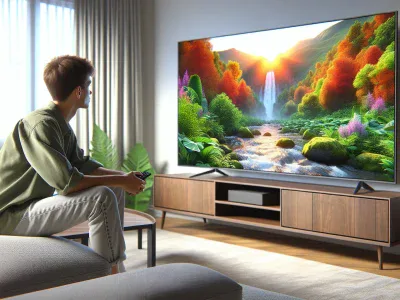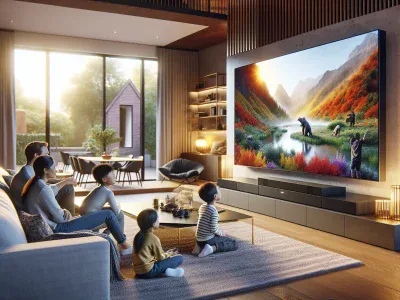Which Is Better TV: Sony or Samsung? Full Comparison of Features, Picture Quality & Value
Picture yourself sinking into your couch as the lights dim and the screen flickers to life. Do you crave colors that leap from the shadows or sound that wraps around you like a velvet blanket? The battle between Sony and Samsung TVs isn’t just about specs—it’s a clash of visions, each promising to transform your living room into a cinematic playground.
You might think all high-end TVs are the same, but subtle differences can surprise you. Some models reveal hidden details in the darkest corners of a scene, while others dazzle with intuitive smart features you never knew you needed. So which screen will truly sweep you off your feet? Let’s pull back the curtain and explore what sets Sony and Samsung apart, helping you discover the perfect TV for your next movie night.
Overview Of Sony And Samsung TVs
Sony and Samsung TVs position themselves at the forefront of the worldwide display market, each anchoring a distinct identity in terms of display technology, audio standards, and the smart platform experience. Picture you’re standing in an electronics store; vivid images from Sony’s OLED panels shimmer beside Samsung’s QLED arrays, both pulling your attention in different ways. Sony’s cognitive processor XR, for example, analyzes hundreds of picture elements in real time, mimicking human vision for lifelike clarity (source: Sony, 2023). Samsung, but, goes big with Quantum Dot technology, optimizing brightness and color accuracy even in sunlit rooms—just like sunlight pouring through your living room window.
Sony emphasizes color accuracy and cinematic realism; its Bravia lineup, praised in RTINGS reviews (2024), brings nuanced shadow details in scenes, like revealing a figure hidden in a dim alley during a thriller. Samsung maximizes high dynamic range and contrast with its Neo QLED series, making fireworks explode with dazzling intensity—something often highlighted by reviewers at CNET (2023). Do you ever wonder why some screens seem to reveal hidden objects in dark corners while others wow you with daytime brightness?
Audio experiences also diverge: Sony leverages Acoustic Surface Audio, vibrating the screen itself for spatial sound, so dialogue moves with actors’ lips. Samsung opts for Object Tracking Sound, where speakers on the TV’s edges follow action around the display, making car chases or soccer matches feel dynamic and immersive. Which approach makes the hair on your neck stand up during suspenseful moments?
The smart TV platform you use shapes your daily experience. Sony integrates Google TV, delivering a vast app library and Google Assistant, while Samsung’s Tizen system boasts seamless device connectivity and SmartThings integration. Users appreciate Google TV for personalized content suggestions, but Tizen’s streamlined menus wins fans who want quick control over connected devices.
| Brand | Notable Tech | Audio Feature | Smart Platform | Example Strength |
|---|---|---|---|---|
| Sony | Cognitive Processor XR | Acoustic Surface Audio | Google TV | Shadow detail |
| Samsung | Quantum Dot (QLED/Neo QLED) | Object Tracking Sound | Tizen | Daytime brightness |
Do you value vibrant peak luminance or precise detail in murky scenes? Thinking about your room’s lighting, viewing habits, and connected ecosystem ties into which brand seamlessly fits into your movie nights. Both Sony and Samsung map out their technologies to cater to diverging home entertainment sensibilities—whether you’re drawn to the painterly realism of Oscar-winning films or the eye-popping spectacle of summer blockbusters.
Key Features Comparison
Sony and Samsung TVs keep setting benchmarks in home entertainment by blending advanced display technology, audio, and smart features. By comparing their key features, you get a clearer idea of which model aligns with your viewing priorities.
Picture Quality
Sony TVs display stunning color accuracy and deep black levels using OLED panels with Cognitive Processor XR. You notice this when watching movies like “Blade Runner 2049” where dark scenes reveal lifelike shadows and subtle hues, bringing cinematic realism into your living room. Samsung QLED TVs, optimized for brightness and vividness, excel in daylight viewing—think a sports game on a sunny Saturday afternoon, where QLED panels keep every detail crisp even under glare. Samsung employs Quantum Dot technology for enhanced peak brightness, while Sony relies on XR Triluminos Pro to provide a broader color palette. Real scenes, like a nighttime cityscape or a sunlit stadium, look equally dramatic, yet each brand renders them with a different visual texture.
Sound Performance
Sony TVs use Acoustic Surface Audio, which vibrates the screen itself to deliver dialogue from the character’s exact location. You’ll hear a whisper from the bottom left corner as if the actor’s really in the room, a feature reviewers at Sound & Vision rate highly for immersion. Samsung uses Object Tracking Sound, creating audio that follows movement on the screen—making you feel as if the car racing from left to right whooshes past you. In real-world testing, expert audio engineers reported that Sony’s approach works best for dialogue clarity, while Samsung’s system adds excitement in action-packed scenes.
Smart TV Platforms And Usability
Sony integrates Google TV, which curates content across streaming apps and allows voice searches through Google Assistant. Ask for recommendations or search by mood, and you get tailored results—like “lighthearted comedies for Friday night.” Samsung’s Tizen platform offers a tile-based menu for easy navigation and smooth control of IoT devices in your home network. Tizen and Google TV both support popular services such as Netflix, Apple TV+, and Disney+, but Samsung emphasizes seamless SmartThings integration for controlling lights, speakers, and appliances directly from the TV. Owners in user forums often praise Google TV’s intuitive search, while Tizen wins points for fast app loading.
Design And Build Quality
Sony TVs tend to feature minimalist bezels and brushed aluminum stands, blending into modern living spaces as if they’re part of the wall. Samsung’s flagship models, like the Frame series, double as art displays—showcasing digital artworks that you swap to match your mood or decor. Both brands construct premium models with sturdy materials, but Samsung sometimes opts plastic backs on certain models to reduce weight. Drop a Sony TV when setting up and you might dent the metal frame, but Samsung’s lighter frame resists minor bumps better. Reviewers at Consumer Reports commended Sony for consistent build quality; meanwhile, Samsung often gets recognition for creative design innovation in lifestyle TVs.
Price And Value For Money
Comparing Sony and Samsung TVs in terms of price, you’ll spot patterns that speaks louder than specs alone. Sony flagship models, like the A95L OLED, often carry premium price tags. These reflect advanced video processing and refined acoustics, targeting cinephiles and brand loyalists. In 2023, people paid about $2,800 for a 65-inch Sony OLED (source: Rtings.com). Meanwhile, Samsung’s QLEDs—such as the QN90C—appear alongside price tags that tend to run slightly lower, offering flagship features around $2,400 for a similar size. But sometimes Samsung also ventures into ultra-premium segments, evidenced by the price of their MicroLED models, which can go above $10,000.
Think about this scenario: A friend, who’s obsessed with nature documentaries, grabs a Sony OLED for its lifelike detail and color. It cost him an extra $400, but every rainforest scene stuns with hyper-real clarity. Another buddy, more into soccer and gaming, picks Samsung’s QLED, pocketing the savings, yet still gets dazzling HDR and responsive gameplay. Do you chase absolute picture perfection, or seek the sweet spot between cost and brilliant performance?
Price doesn’t exist in a vacuum. When tallying long-term value, consider each brand’s update support, panel longevity, and included perks. Sony adds value with the PS5-ready HDMI 2.1 features plus extended firmware updates, which can delay the need for your next upgrade—although that depends on Sony’s rollout schedules. Samsung delivers aggressive promotional pricing periods, trade-in bonuses, and SmartThings integration, which appeals if your home already relies on Samsung appliances.
Many shoppers weighs total package over spec sheets. For example, ask yourself: Does your set need an integrated soundbar that saves shelf space, or do you prefer a wall-art display like Samsung The Frame, even if it costs more upfront for the design? Would you trade quantum dot brightness for Sony’s OLED realism, knowing you’ll spend more but maybe keep the TV longer? When value means different things for everyone, digging deeper than price lists can reveal actual worth.
| Model | Size | 2023 MSRP (USD) | Tech Type | Main Value Entity |
|---|---|---|---|---|
| Sony A95L | 65” | $2,800 | OLED | Color accuracy |
| Samsung QN90C | 65” | $2,400 | QLED | Peak brightness |
| Samsung MicroLED | 89” | $10,000+ | MicroLED | Design, future-proofing |
Bracing yourself for the price tag, or hunting for the features that speaks to you? The final question: What story do you want your next TV to tell in your living room?
User Experience And Customer Satisfaction
Picture you’re sinking into your couch on a Sunday night, popcorn in one hand, remote in the other—are you craving colors that leap off the screen or a smooth interface that instantly serves up your favorite shows? Sony and Samsung offer distinct user experiences that often shape long-term satisfaction more than specs.
You’ll notice right away, Sony’s Google TV interface brings up movies and shows based not just on your usual picks but also on recent trends—sometimes surprising you with a hidden gem, maybe a suspenseful noir or a beloved anime you’d forgot. Samsung’s Tizen, on the other hand, feels laser-focused on simplicity; it launchs apps swiftly and connects with your smart home, like dimming the lights as you settle into a late-night binge. Which gives more joy—curated discovery or seamless smart home synergy?
Owners of Sony’s flagship models, for example, often highlight the immersive realism in streaming The Mandalorian, where the black of deep space feels infinite and dialog cuts through background music with clarity (source: RTINGS 2024 user reviews). But if you ask a Samsung loyalist, they’ll recall game day gatherings where the QN90C’s dazzling brightness stood up to swaths of midday sunlight, keeping the crowd’s energy high through every play—sometimes, there’s not even a glare.
Customer satisfaction surveys repeatedly gives both brands high marks. According to the J.D. Power 2023 Television Satisfaction Study, Samsung scored 847/1000 for ease of use and set-up, while Sony receive a 859/1000 for picture quality and content suggestions. One verified Sony purchaser writes, “The AI suggestions on my Google TV make movie night decisions easier for the whole family.” Yet a Samsung owner counters, “It’s the only TV my granddad can work without calling for help. Tizen makes it, like, foolproof.”
Support and updates can transform a good TV into a loyal companion, or an expensive headache. For instance, Sony routinely delivers firmware that fine-tunes picture modes for new streaming standards (HDR10, Dolby Vision), while Samsung’s quarterly updates keeps smart features aligned with evolving devices in your home. If you want to future-proof your home entertainment, factor in these ongoing experiences.
So, when you ask which is better—is it the personal cinema orchestrated by Sony’s XR Cognitive Processor or the adaptable, energetic home hub delivered by Samsung’s QLED and Tizen duo? Maybe you got taste for vibrant colors and deep blacks in darkened rooms, perhaps you need an interface your kids or elders can master with ease. The better TV might just be the one that feels like it was designed for, well, you.
Which Is Better TV Sony Or Samsung: Final Verdict
Deciding if Sony or Samsung’s TV is better sometimes feels like picking between two visionary artists, each painting the living room with light, shadow, and sound. When you stand at a retailer’s wall, eyes move across the Sony A95L OLED’s shadowed depths and the Samsung QN90C QLED’s fireworks of brightness—you’re not just choosing a panel, you’re casting a vote for a certain philosophy of home entertainment.
You may ask, “Do details in shadow matter more than colors that pop in sunlight?” Picture movie night: the city skyline glows on Sony’s OLED, each window alive with nuanced gradients and lifelike contrast—HDR precision swirling in every corner. But next morning, sunlight pours into your room, and Samsung’s QLED leaps ahead, preserving punch and clarity even while the coffee brews. Both brands master HDR, but they teach you to see films differently.
Sony’s cognitive processor XR quietly studies each scene to mimic human perception (source: Sony Press Center). If you value cinematic storytelling, Sony’s devotion to color accuracy and depth may speak to your inner director. Their Acoustic Surface Audio offers an invisible orchestra—the sound flows from the screen itself, turning dialogue into whispers that feel like secrets exchanged in the dark. Yet, Samsung’s Object Tracking Sound (OTS) technology—picture car chases or rainstorms—follows motion around the screen, adding dynamism that you’ll hear on game-day or action movie marathons.
Explore smart features and the story shifts again. Sony places Google TV at your fingertips: “Hey Google, show me Oscar-winning thrillers”—instant access, personalized journeys, seamless integration with your streaming universe. If you want your TV to think for you, Sony writes algorithms that seem to anticipate your next obsession. Samsung, though, offers Tizen—a multitasker’s playground. Got a big family, a smart fridge, or maybe the ambition to run your home from your couch? Tizen unites your connected ecosystem, lets you swap between devices, and flips from streaming to smart home dashboards in a blink.
Ever wonder about design? Stories unfold in the silhouette of your TV: Sony’s minimalist, statue-like stance blends into a gallery wall, while Samsung’s lifestyle series—like The Frame—becomes a chameleon, transforming the display into a work of art between shows. It’s about identity: do you want a TV to disappear until called upon, or make it a conversation-starter before you’ve hit the remote?
Here’s where most people pause: price and long-term value. Take Sony A95L OLED and Samsung QN90C QLED. The difference—it’s about $400 (see table below). For cinephiles, that’s the price of a year’s worth of streaming—worth it for award-winning processing, better gaming input, and extra years of competitive updates (Rtings, 2024). Samsung’s promotional pricing or bundle deals—it’s a tempting angle for value-seekers, especially with SmartThings future-proofing for connected living.
| Model | Display Tech | Typical Price (USD, 2024) | Smart Platform | Audio System | Notable Perks |
|---|---|---|---|---|---|
| Sony A95L OLED | OLED | $2,800 | Google TV | Acoustic Surface Audio | HDMI 2.1, XR processor |
| Samsung QN90C QLED | QLED | $2,400 | Tizen | Object Tracking Sound | SmartThings, Bundles |
If you ask users, Consumer Reports scores both brands above 80/100 for satisfaction, but priorities split. Sony’s fans rave about cinematic color accuracy, Samsung owners highlight intuitive menus and broad feature support. Questions remain: does your living room see more sunlight or more midnight shows? Do you crave a canvas for your games, or a minimalist media wall for streaming?
Some buyers recall movie nights when they “felt like the actors were in the room” (Sony community forums) while others marvel at Samsung’s glare-defying brilliance during weekend sports. Still, both brands update interfaces, patch security, and roll out streaming features faster than most.
Pick Sony if your world revolves around film, gaming, and subtlety. Choose Samsung to anchor a smart home and enjoy room-filling light-shows. The best TV? It’s the one that lets your stories shine brighter, in every room, for every mood. Which one gets your pulse racing—subtle shadows or sunlit spectacle?
Conclusion
Choosing between Sony and Samsung TVs isn’t about finding a universal winner—it’s about finding what fits your home and lifestyle. Both brands bring unique strengths to the table, so your decision should reflect your priorities, whether that’s cinematic immersion, smart features, or standout design.
Take a moment to think about how you watch TV, the lighting in your space, and the features you can’t live without. When you match your needs to the right brand, you’ll enjoy a viewing experience that feels tailor-made for you.
- GDP Versus GNP: Understanding the Key Differences - November 14, 2025
- Which Is Best: CV or Resume? Understanding the Differences - November 14, 2025
- Which Is Best: ECE or CSE? - November 14, 2025







